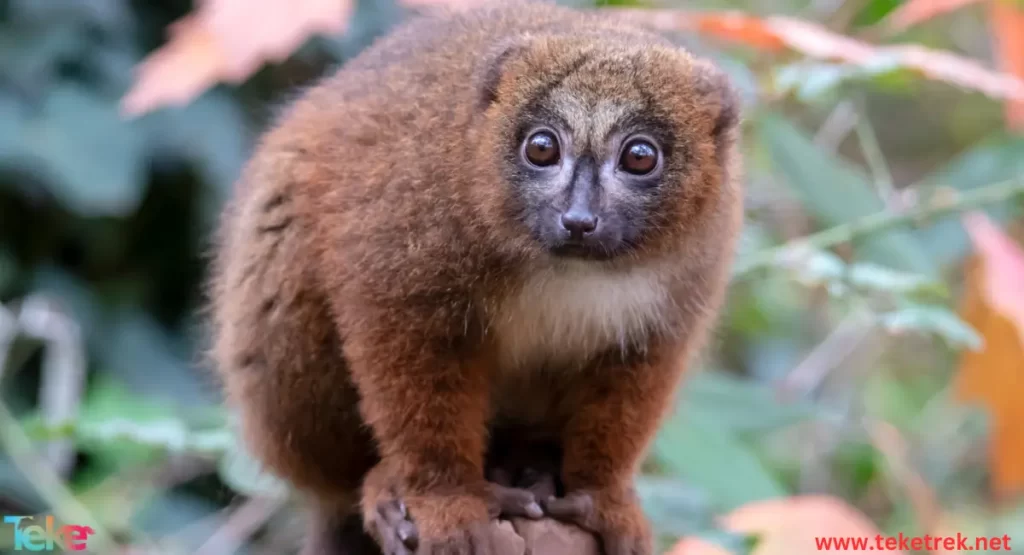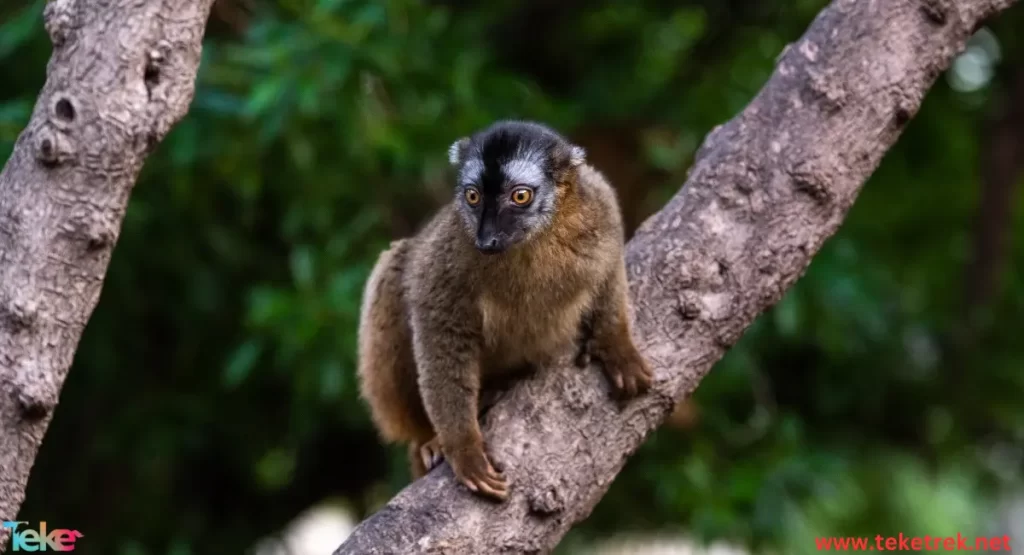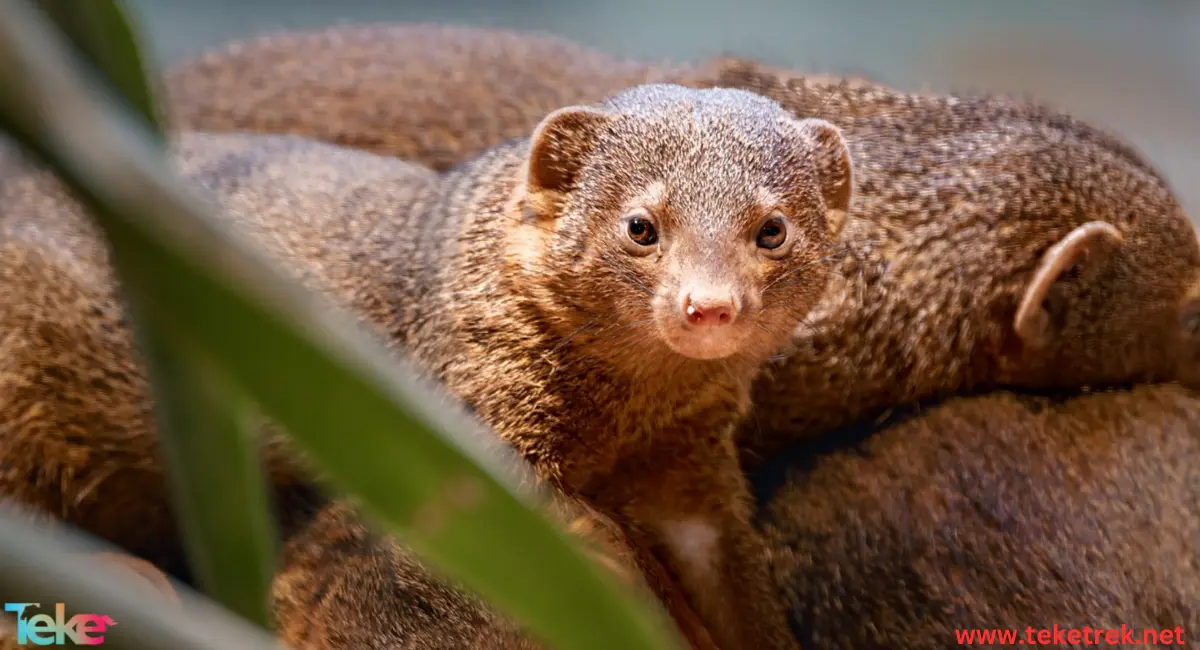Kinkajous are mammalian animals that inhabit tropical rainforests. They prefer living in trees and have developed a largely arboreal lifestyle, not being associated with any other arboreal mammal groups.
Belonging to the order Carnivora, family Procyonidae, and class Mammalia, the Kinkajou is a member of the animal kingdom.
Let’s learn more about it from teketrek.

General Appearance of the Kinkajou:
Its head is round, its eyes are large, and its nose is short and pointed.
It has short limbs and a long tail capable of grasping onto anything.
Its eyes reflect bright green or yellow when exposed to light.
They possess a long, thick tongue capable of significant projection.
Their noses are dark brown to black in color.
Its fur color changes depending on the area it is in or the time of year.
Kinkajous may be olive-yellow, woody brown, or yellowish on the upper part of the coat, while the lower parts can be orangish, yellow-brown, or brownish-yellow.
Its fur is short, woolly, and dense, and its tail is covered with thick fur to the tip.
Females of the species are typically smaller than males.
Locations of Kinkajou Habitats:
It is found in both North and South America.
They prefer tropical rainforests, both dry and humid.
Kinkajous inhabit areas ranging from southern and eastern Mexico’s Sierra Madre Mountains, through Central America to Bolivia east of the Andes Mountains, as well as the Atlantic Forest in southeastern Brazil.
Habits and Lifestyle of the Kinkajou:
Kinkajous are strictly arboreal and nocturnal creatures. Previously thought to be solitary, recent studies have revealed a complex social system.
Social groups typically consist of one female and two males, although they may also include adults and juveniles.
During the day, Kinkajous sleep in dens, often in tree hollows or forks, usually with members of the original group.
At dusk, group members spend time socializing and mingling before separating for foraging.
Kinkajous usually forage alone, except when feeding on large fruiting trees where competition is lower due to abundant food supply.
Whether in small groups or alone, Kinkajous typically follow the same nightly routes and usually adhere to their territories.
They mark their territories using scent glands located in the corners of the mouth, throat, and abdomen.
Diet of the Kinkajou:
Kinkajous are primarily frugivorous animals, feeding on fruits such as watermelon, apples, bananas, figs, grapes, and mangoes.
They also consume nectar, berries, bark, leaves, as well as frogs, insects, honey, birds, and eggs.
Most of the water their bodies need comes from their food, although they drink water on leaves or in tree cracks.
Studies have shown that 90% of the Kinkajou’s diet consists of fruits, with the remaining 10% comprising leaves, flowers, and various other herbs.
In rare cases, Kinkajous may eat eggs, chicks, insects, and small vertebrates.
Reproduction in Kinkajous:
Kinkajou are polyandrous, meaning both males and females mate with multiple partners.
Reproduction occurs throughout the year, with a gestation period of 98-120 days.
After 2 to 6 weeks, the offspring open their eyes, and between 3-6 weeks, their tails become capable of grasping objects.
The mother fiercely protects her young, carrying her offspring on her abdomen wherever she goes. However, after weaning, the mother places her young in a nearby tree during nursing.
Offspring are weaned when they reach 8 months of age.
Male Kinkajous reach sexual maturity at around 18 months, while females reach maturity at 2-3 years of age.
Threats to the Kinkajou:
Threats include deforestation, being sold as pets, and hunting for their soft fur and delicious meat.
Habitat destruction by humans has led to a decline in the numbers and distribution of Kinkajous. Most habitat destruction is likely due to deforestation.
Some Facts about Kinkajous:
- Another name for the Kinkajou is “Honey Bear,” given because of its clawed feet and round ears.
- Kinkajous are arboreal animals and possess numerous arboreal adaptations, such as a long tail capable of grasping objects, agile clawed fingers, and fully reversible hind feet.
- The peak activity of Kinkajous usually occurs between 7 p.m. and midnight or an hour before dawn.
- During the day, Kinkajous sleep in tree hollows or tangled, shaded foliage, avoiding direct sunlight.
- Kinkajous live in small social groups typically consisting of one male, one female, and related offspring.
- Members of the same group sleep together during the day in a shared nest or den and venture out at dusk for mating and socializing. They forage individually most of the night but return together in the morning to sleep.
- Kinkajous are known for their loud vocalizations, emitting screams, barks, and a variety of quieter sounds, including some described as “sneezes.”
- It breeds throughout the year, and the female gives birth to one or two young after a period ranging from 112 to 118 days.The mother bears full responsibility for caring for her young.
- Although Kinkajous may resemble monkeys or rodents, they are not related to these animals. They are related to Olingos, Coatis, Raccoons, as well as Ringtails and Cacomistles.

FAQ
- What is the lifespan of a kangaroo?
A kangaroo can live up to 26 years.
- What is the length of a kangaroo’s tail?
A kangaroo’s tail is above 0.4 m.
- What are the characteristics of the kinkajou?
The characteristics of the kinkajou include:
- Excellent jumping ability.
- Abdominal pouch for carrying young.
- Long and strong tail.
- Social life in groups.
- Herbivorous diet as a primary food source
- What do Kinkajous eat?
Kinkajous primarily eat fruits, particularly figs, but they also consume other plant matter such as flowers, nectar, and leaves. Additionally, they may eat small vertebrates like birds, eggs, and insects, making them omnivores.
- Where do kinkajous live?
Kinkajous are native to Central and South America, inhabiting the rainforests of countries such as Mexico, Central America, and parts of South America, including Brazil, Bolivia, and Peru. They are primarily arboreal creatures, meaning they live in trees, and they can be found in dense tropical forests where they can easily navigate through the canopy.
- Are kinkajous aggressive?
Kinkajous are generally not considered dangerous to humans. They are shy and nocturnal animals that typically avoid human contact. But like any other wild animal, they defend themselves when necessary.
In conclusion, the kangaroo emerges as a fascinating and intriguing creature in our natural world. It plays a significant role in the ecosystem as both a predator and a widely spread species. Its unique behavior warrants study and protection.
Despite the challenges these animals face due to habitat loss and illegal hunting, current efforts to protect and conserve them offer hope for the continued existence of this unique species in the wild. Through awareness, advocacy, and ongoing support, we can contribute to preserving biodiversity and maintaining the balance of ecosystems for future generations.
Reference





